
As the world deals with the COVID-19 pandemic, SHIC continues to focus efforts on prevention, preparedness, and response to novel and emerging swine disease for the benefit of US swine health. As a conduit of information and research, SHIC encourages sharing of its publications and research. Forward, reprint, and quote SHIC material freely. SHIC is funded by America’s pork producers to fulfill its mission to protect and enhance the health of the US swine herd. For more information, visit https://www.swinehealth.org or contact Dr. Sundberg at [email protected].
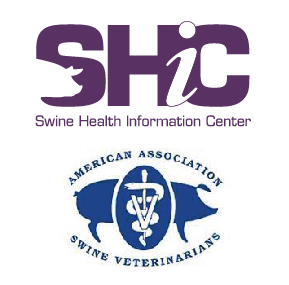
In response to a recent increase in submissions related to swine lameness at veterinary diagnostic labs (VDLs) in Iowa and Minnesota, the Swine Health Information Center (SHIC) and American Association of Swine Veterinarians (AASV) are sponsoring another in a series of industry chatter-inspired webinars on October 13, 2020, beginning at 1:00 pm CT. This 90 minute event will include experiences and advice on what makes a successful investigation of lameness. Webinar participants include swine practitioner Dr. Mike Eisenmenger of the Swine Vet Center, Drs. Kathleen Wood and Paul Cline of Christensen Farms whose focus is on research and nutrition, and diagnosticians Dr. Mike Rahe, Iowa State University VDL, and Dr. Stephanie Rossow, University of Minnesota VDL.
A wholistic investigation including timely sampling and appropriate tissues being submitted to the veterinary diagnostic laboratory is needed. During the webinar on October 13, presenters will review possibilities, protocols, and their experience dealing with lameness in swine herds, answer questions from participants and provide insights for producers and their veterinarians dealing with lameness issues.
The latest in a series of webinars responding to industry events, the intent is to provide information, experience, and insight into issues being discussed in the industry. Previous webinars in this series have addressed viral myelitis, tracheitis, and most recently, coccidiosis. Ideas for future webinars are invited. Please contact Dr. Paul Sundberg, SHIC executive director, with your suggestions at [email protected].

Two new PCR tests have been added to the Swine Health Information Center (SHIC) Diagnostic Assay Catalog. A highly sensitive and specific RT-PCR for detecting porcine sapovirus (SaV) genotype III for neonatal diarrhea investigation and a single-tube triplex real-time PCR (RT-PCR) assay for differential detection of variant strains of pseudorabies virus (PRV), including the Chinese high path strain, gives diagnosticians previously unavailable valuable tools. Each is now available to all veterinary diagnostic labs for use and fits with SHIC’s mission to make sure the US swine industry is prepared for emerging diseases.
The sapovirus PCR project resulted from a refractory case of piglet diarrhea in the lactation phase for more than two years on a farm. Pigs in the case study exhibited a self-limiting diarrhea starting around 10 days of age, but typically lost one to two pounds of expected weaning weight. Researchers use of four independent lines of evidence in this case – metagenomics analysis, real-time RT-PCR, histopathology, and in situ hybridization – confirm that porcine SaV of genogroup III as the cause of the enteritis and diarrhea.
A subsequent prevalence survey of more than 500 samples comparing pigs with clinical diarrhea and clinically healthy pigs suggests that porcine SaV genotype III may play an important role in causing swine enteritis and diarrhea. Study findings provide significant insights for a better understanding of the epidemiology and pathogenicity of porcine SaV. To the researchers’ knowledge, this is the first evidence SaV likely serves as the sole etiological agent causing enteritis and diarrhea of piglets in the field in the United States. Having effective diagnostics for pathogens on the Swine Viral Disease Matrix and the Swine Bacterial Disease Matrix is key to discovery and detection which is essential for effective management.
The single-tube triplex real-time PCR (RT-PCR) assay for differential detection of variant strains of pseudorabies virus (PRV) is able to differentiate wild-type classical (Bristol) and Chinese variant PRV and the gE-deletion PRV mutant marker vaccines. It could be used as a rapid diagnostic tool for foreign animal disease detection in North America, or for surveillance and in epidemiological studies in countries, like China, where both classical and variant strains of PRV are endemic.
The clinical specificity and sensitivity of the assay was evaluated using whole blood, serum, tissue, and swab samples collected from known negative and experimentally inoculated pigs with either classical (Bristol) or variant (JS-2012 and HeN1) PRV strains. The targeted genomic region of this assay is also deleted in commonly used PRV gE-deleted marker vaccines, and therefore, the triplex assay did not detect viral DNA extracted from two commercial vaccine strains Bartha K-61 and Bucharest. This single-tube triplex assay can be used for routine diagnostics and epidemiological studies for detection and differentiation of classical strains from variant strains of PRV, and as a differentiation of infected and vaccinated animals (DIVA) assay when PRV gE-deletion mutant marker vaccines are used.
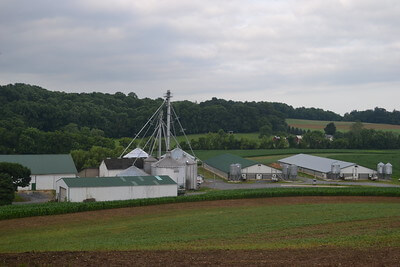
Research funded by the Swine Health Information Center at North Carolina State University shows it is possible to develop accurate forecasts of porcine epidemic diarrhea virus (PEDV) spread within a decision-making timeframe. Results also show predictability of this forecasting depends on the stage of the spread within the region. By forecasting outbreaks before they occur, specific control strategies can be tailored to farms, thereby offering an opportunity to prevent infection.
The objective of the study was to develop a way to forecast PEDV outbreaks by generating weekly high-resolution maps to track spread and identify current and future PEDV high risk areas. Within the outbreak models, the researchers then tested a combination of strategies that might reduce between-farm transmission, knowing this is key to maintain control of outbreaks while minimizing production disruptions.
Three epidemiological transmission models were compared in this work: a) a novel epidemiological framework called PigSpread developed specifically to model disease movement in swine populations, b) SimInf, a program that models disease spread as a more random event, and c) PoPS (Pest or Pathogen Spread), a framework for modeling the spread of pests or pathogens across a landscape. The models were calibrated on true weekly PEDV outbreaks from three spatially related swine companies within the study region. Model outputs had general agreement with observed outbreaks throughout the study period with some variability between models. The analysis estimates of the combined strategies of herd closure, feedback, and reinforcement of on-farm biosecurity reduced the incidence of outbreaks in sow farms by 14% and in gilt development units (GDU) by 20% when deployed weekly in sow and GDU farms located in risk areas.
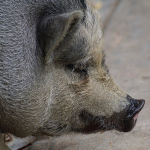
This year, USDA estimates there are 6 million feral swine in the US creating issues for traditional livestock production, natural resources, and other species. To address these ongoing issues, including domestic and foreign disease surveillance priorities of feral swine, USDA convened a technical working group consisting of swine industry representatives, state and federal animal health officials, university, and wildlife experts, including Dr. Paul Sundberg, executive director of the Swine Health Information Center. Dr. Harry Snelson, American Association of Swine Veterinarians, Dr. Dave Pyburn and Dr. Patrick Webb, National Pork Board, Dr. Liz Wagstrom, National Pork Producers Council and Bobby Acord, a consultant with the National Pork Producers Council, also participated. The published review and recommendations report was a collaborative effort between USDA and the other groups for the purpose of addressing the feral swine threat to domestic swine health.
In an article published in the Journal of Animal Science (2020, Vol. 98, No. 8, 1-3), “Perspectives on the past, present, and future of feral swine disease surveillance in the United States,” progress in management of feral swine is detailed. In describing the importance of feral swine management, authors write, “The rapid global spread of ASF (African swine fever) virus in the last 1-2 years in both domestic and wild swine has highlighted the need for vigilant surveillance and demonstrated the devastating impact of a foreign animal disease due to mortality, production losses, and restrictions to international trade.”
The National Feral Swine Damage Management Program (NFSP) was created in 2014 with the mission of managing feral swine disease damage. Per the published report, about 3000 samples from feral swine are tested each year for antibodies against classical swine fever (CSF), swine brucellosis (SB), and pseudorabies (PRV). A targeted surveillance program prioritizes counties based on existing feral swine populations, domestic pork production, landfills, and other disease-driven factors.
USDA Animal Plant Health Inspection Service (APHIS) established eight priorities for NFSP in 2018. A full review of the priorities is available here. In brief, they are:
Progress on each of these priorities is included in the report which also includes 2020 direction and priorities for NFSP. An updated framework for surveillance was designed. The first priority for the revised system was function as an FAD surveillance system. Specifically it focuses on CSF (serologic) and ASF (morbidity and mortality) as well as FMD (syndromic). Another priority was for the framework to be nimble enough to respond to emerging threats. Further details on 2020 direction are included in the full report.
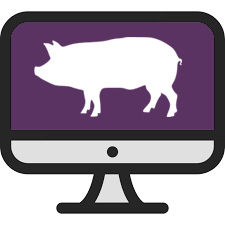
In the Swine Health Information Center’s (SHIC’s) August 2020 Domestic Swine Disease Monitoring Report, there was a significant increase (signal) in diagnoses of coccidiosis observed from June 27 to July 11, per submissions to the Iowa State University Veterinary Diagnostic Lab. This unexpected increase in activity prompted development of a webinar for pork producers, practitioners, academicians, and other stakeholders on coccidiosis management, sponsored by SHIC and the American Association of Swine Veterinarians.
In summarizing the presentations at the conclusion of the webinar, Locke Karriker, DVM, Iowa State University Swine Medicine Education Center director, said coccidiosis management requires remembering it’s a protozoa, not a virus, causing the issues seen in farrowing rooms. Limited prevention tools and treatment options hamper effective management. Morbidity, including lower weights of affected piglets, is the primary issue resulting from coccidiosis. He also noted there are several species of oocysts with each responding differently to treatment and prevention protocols implemented.
Held on Thursday, September 3, 2020, the webinar was conducted by the Iowa State University Swine Medicine Education Center. Presenters were Jeremy Pittman, DVM, Smithfield North Region, Amber Strickler, DVM, Suidae Health & Production, Kent Schwartz, DVM, MS, Iowa State University College of Veterinary Medicine/Veterinary Diagnostic Lab, and Robert Friendship, DVM, University of Guelph, Ontario Veterinary College.
Visit the National Hog Farmer to read a summary of the webinar written by Ann Hess, beginning, “Jeremy Pittman says it’s been a “nagging” cause of scours his entire career in swine medicine. Historically, it’s an indicator of poor management, but Amber Stricker says the last five years she has been seeing it more commonly in well-managed commercial farms.
“It is coccidiosis, and while it is often placed lower on the list of swine enteric diseases, and diseases in general, both veterinarians say they have seen the coccidia parasites play a major role in increasing morbidity and poor weight gain in suckling pigs, nurseries and wean-to-finish.”
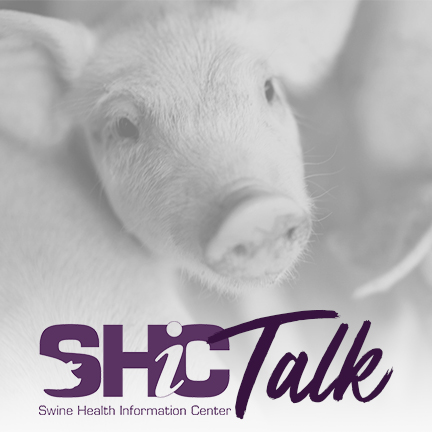
The mission of the Swine Health Information Center (SHIC) is to protect the health of the US swine herd. Activities related to this goal center on monitoring, preparedness, prevention, and response to new or emerging swine diseases that could impact US herds. For each of these disciplines, information is SHIC’s primary commodity.
SHIC’s recently introduced podcast, SHIC Talk, provides in-depth and insightful information on topics important to the pork industry. Look for the next episode of SHIC Talk addressing the Rapid Response Program to be posted soon! Previous episodes included discussion of test-and-remove African swine fever management protocols in China and increasing coccidiosis diagnoses domestically.
To be relevant to US pork producers, SHIC shares information often via a variety of means, including industry events such as the recently concluded Leman Swine Conference, new vehicles like the new SHIC Talk podcast, articles prepared for partners including the American Association of Swine Veterinarians, webinars, industry media, as well as SHIC’s own monthly newsletter and constantly updated website.
Your input on industry chatter to be addressed on an episode of SHIC Talk, topics for webinars and articles, and contributions for the SHIC newsletter are always welcome. Please reach out to SHIC Executive Director Dr. Paul Sundberg at [email protected].
As the world deals with the COVID-19 pandemic, SHIC continues to focus efforts on prevention, preparedness, and response to novel
and emerging swine disease for the benefit of US swine health.

This month’s Domestic Swine Disease Monitoring Report shows a substantial increase in case positivity for porcine reproductive and respiratory syndrome virus (PRRSV), and a moderate increase for porcine epidemic diarrhea virus (PEDV), and porcine deltacoronavirus (PDCoV) cases in September compared to August in wean-to-market animals. A moderate increase in the detection of PEDV in the adult/sow farm category was also presented. Detection of Mycoplasma hyopneumoniae had a substantial increase in all age categories, as predicted by the forecasted model. At a state level, detection of PRRSV was three standard deviations above expected in Missouri, Nebraska, and Indiana. In the podcast, SDRS hosts talk with Mark Schwartz about a producer experience in using veterinary diagnostic data-driven decisions to improve animal health. They also discuss disease management’s economics and the value of year-round disease monitoring and surveillance to apply practical interventions.

In the October Global Swine Disease Monitoring Report, the first reports of African swine fever in Germany are detailed. On September 10, Germany confirmed ASF in a wild boar found near the Polish border. Since then, another 48 cases have been reported in wild boar. Classical swine fever (CSF) was reported for the first time in a pig farm in Gunma prefecture, Japan. On September 3, Japan officially lost its disease-free status for CSF. Previously (September 2018), the OIE had given Japan a two-year suspension status, after confirming the first CSF outbreak in 26 years in a pig farm in Gifu prefecture.
Copyright 2025 | Swinehealth.org | Website by Heartland Marketing Group